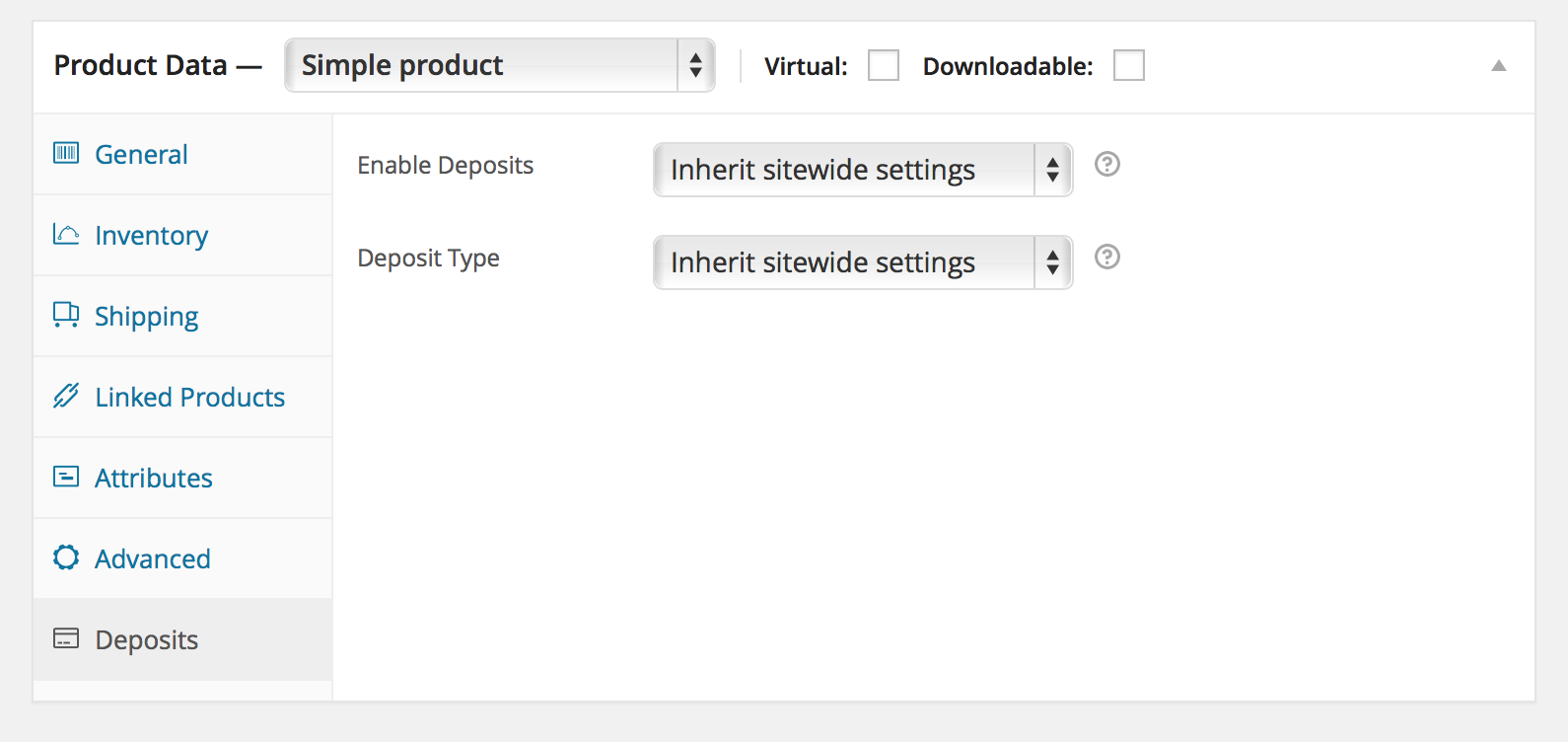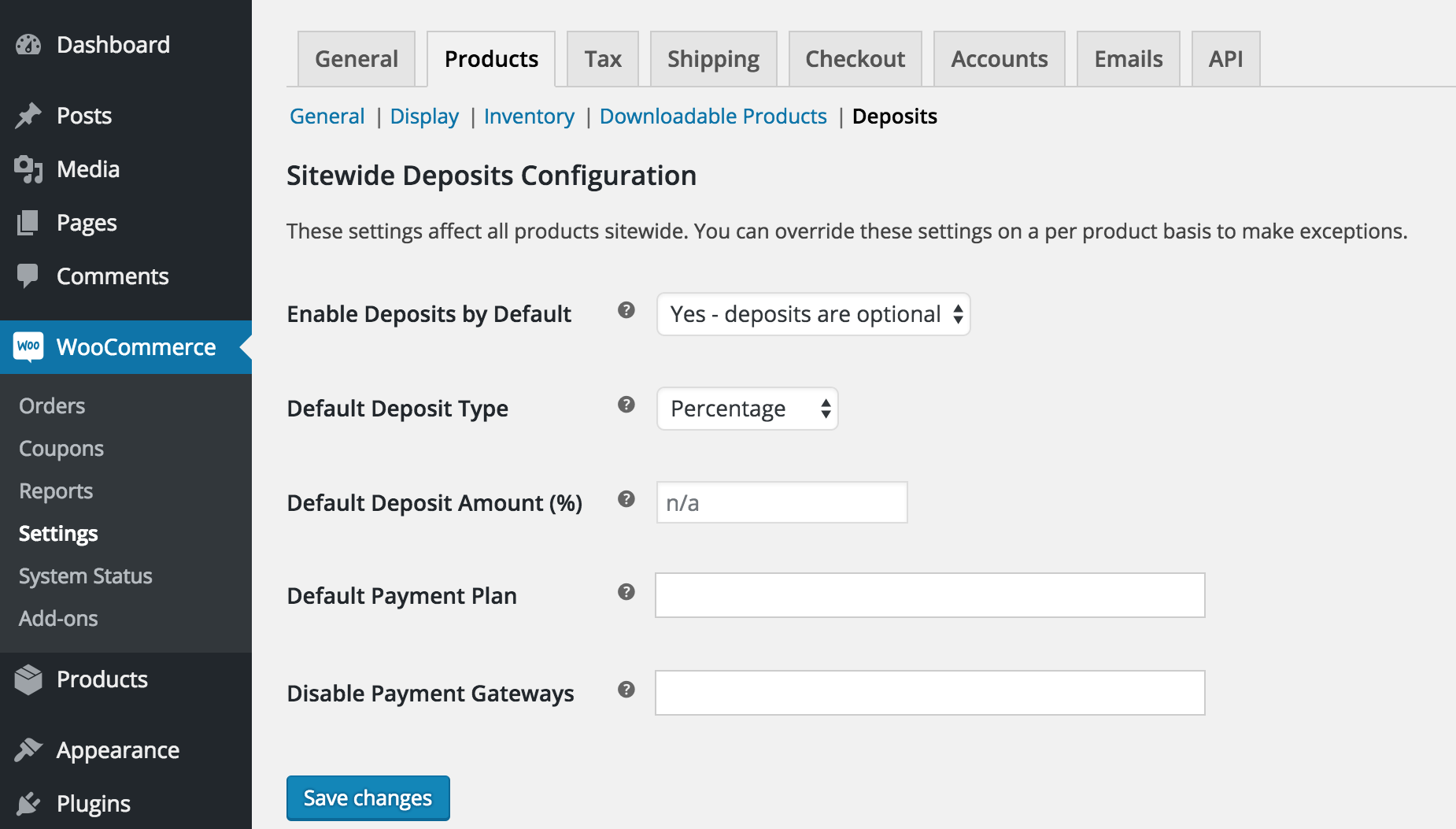WooCommerce Deposits 1.2.3 Extension
WooCommerce Deposits 1.2.3 Extension
Download
http://getlot.co/shop/woocommerce-deposits-extension/
Get it now

Download
http://getlot.co/shop/woocommerce-deposits-extension/
Get it now
WooCommerce Deposits
Our WooCommerce Deposits extension allows you to select products or services on which you would accept deposits or payments. Customers can then place deposits or choose a payment plan on these products, rather than pay in full.
Installation
- Download the .zip file from your WooCommerce account.
- Go to: WordPress Admin > Plugins > Add New and Upload Plugin with the file you downloaded with Choose File.
- Install Now and Activate the extension.
More information at: Install and Activate Plugins/Extensions.
Deposits
Choose whether to give customers the ability to place a deposit on all products or only on some products.
Sitewide Settings
To apply the Deposit option on a global or sitewide basis:
- Go to: WooCommerce > Settings > Products > Deposits.
- Enable Deposits by Default.
- No
- Yes – deposits are optional
- Yes – deposits are required
- Choose Default Deposit Type
- None
- Percentage – use a percentage of the total amount
- Fixed amount – use a fixed amount for all products
- Payment plan – use a predefined payment plan (see below)
- Set Default Deposit Amount (%)
- Enter percentage amount if “Percentage” was chosen
- Enter fixed amount if “Fixed amount” was chosen
- Leave blank if “Payment plan” was chosen
- Choose Default Payment Plan
- Search for available payment plans – payment plan needs to be created first
- Leave blank if “Percentage” or “Fixed amount” was chosen
- Disable Payment Gateways – Allows you to select gateways to disable when a deposit is in the cart
- Save Changes.
Note: If you do not want deposits enabled for all products, skip these settings and go to Product Data Settings below.
Product Data Settings
To apply the Deposit option to only selected products:
- Select or Edit the product to which you want to apply it. A Deposits tab is visible at the bottom, as pictured.
 Set the following options:
Set the following options:- Enable Deposits
- Inherit sitewide settings. The default.
- Yes – deposits are optional. The customer can choose.
- Yes – deposits are required. The customer must give a deposit.
- No. Deposits are disabled for this product, regardless of sitewide settings.
- Deposit Type
- Inherit sitewide settings. The default.
- Percentage. User is charged a percentage, based on product price.
- Fixed Amount. User is charged a fixed amount, regardless of cost.
- Payment Plan. Allows you split the cost into payments – more information below in Payment Plans.
- Enable Deposits
- Click Update when done making changes.
Payment Plans
Payment Plans give customers the option to pay an upfront fee and the remainder at a later date, dividing payments into multiple parts over time. This would be similar to a loan, layaway or credit plan.
Each product can have a different payment plan and deposit if you’ve not applied Deposits “sitewide.”
Adding a Payment Plan
To add a plan:
- Go to: Products > Payment Plans.
- Enter the following into the form on the left side:
- Plan Name – Name shown to the customer when viewing the plan.
- Plan Description – Description shown to the customer when choosing a plan.
- Payment Schedule

The schedule consists of multiple rows, each with a percentage of the entire cost, and the interval after which it should be paid. The first row is the initial payment or deposit:
Select the ‘+’ button on the right side to add another row that represents a future payment:
Adding multiple rows enables you to define the plan’s duration and overall cost. For example, if you want to charge a customer 10% up front and the remainder over six months, the plan would look like this:
Save Payment Plan when finished, and it appears on the right side under Existing Payment Plans:
Editing and Deleting Payment Plans
Existing plans are listed on the right side of the page. Hovering over a plan shows two links: Edit and Delete. The interface for Editing a plan is identical to Adding a plan (above).
Adding Interest to A Payment Plan
Instead of compiling payments to total 100% as above, you would add a percentage to each payment. For example: Payments 1, 2, 3 and 4 wouldn’t be 25% each but 26% each.
You could also opt to add an extra amount to the first payment/deposit — a one-time setup fee, handling fee or a percentage –to ensure against future losses if the customer doesn’t pay on time or pay in full.
Cart and Checkout Flow
If a Deposit or Payment Plan option is available for a product, customers see the following on a single product page.
If the deposit is optional:
If the deposit is required:
If there are payment plans:
Once placed in the Cart, the deposit information is also shown to the customer:
Managing Order Deposits and Payment Plans
After checkout:
- Customers can view the order on their My Account page. This includes future Scheduled payments and the amount, which is updated over time.
- Admin users can see deposit information in Order emails and Edit Order screens.
- If an order contains a deposit, the original order shows a status of Processing (or Partially Paid). You can manually change this if you wish.
- If an order has a payment plan, all follow-up payments have an order created for them with a status of Scheduled.
Managing Deposit Orders
In the backend, when viewing an order, line items paid with deposits look like this:
There are buttons you can use to manage orders with deposits:
- Invoice remaining balance – Create a new order in WooCommerce for the customer with the remaining amount due. It can then be sent to the customer to pay online.
- Mark Paid (offline) – Use this button to declare that the amount has been collected in full offline and is paid.
- View Invoice – If you created an invoice for the remaining balance, a button appears to view this follow-up order.
Once invoiced and paid, or marked paid offline, the order status automatically updates to Completed.
Managing Orders on Payment Plans
In the backend, when viewing an order, line items with payment plans look like this:
The View Scheduled Payments button takes you to the order list, but only show orders created for that plan. These orders have a status of Scheduled and a future order date.
When a Scheduled payment is due, an invoice is automatically sent to the user to request payment on that date. Once all scheduled orders are paid, the plan ends and the original order is marked Completed.
FAQ
How are taxes handled for deposits?
Tax is only calculated for the deposit on a product. Tax on the remainder is charged when the next payment is made.
How are taxes handled for payment plans?
Tax is charged on the initial fee/deposit of a payment plan. Future payments are also created in the system so they use the same tax point/rate (in case it changes during the plan’s term). For clarification on tax points: https://www.gov.uk/vat-instalments-deposits-credit-sales
How are coupons handled for deposits and payment plans?
Coupons are applied according to standard WooCommerce functionality, explained in Coupon Management. You can apply it globally/sitewide or on a per-product basis, excluding or including as you like.
However, if you have a payment plan and an option to pay in full on the same product, it’s not possible to only apply a coupon on the full payment option. This requires conditional logic according to what the customer selects, and this would require customization.
Can I automatically charge customers when a scheduled payment is due?
No, manual and automatic recurring payments are not supported in the current version, so credit card data is not stored. However, we plan on adding this to WooCommerce core in the near future (no ETA at this time).
Can I send an invoice or reminder a few days or a week prior to a payment due date?
Out of the box, Deposits currently has no settings that can do this. The invoice/email notification is triggered by the due date.
If you wish to send a reminder, you need a separate plugin such as Zapier or Follow Ups.
Which payment gateways can I use with Deposits?
Deposits is independent of payment gateways as it does not automatically collect any payments. You can set up any payment gateway you’d like and use Deposits with no issues.
Which plugins/extensions is WooCommerce Deposits compatible with?
You should not need to use Deposits with Preorders or Subscriptions, so they are not compatible. Deposits is not compatible with Wishlists, Composite Products or Product Bundles.
Does the extension work with virtual products?
Yes! Virtual products will not become available until an order is marked as Completed.
Because I am extending credit to my customers, can this extension/plugin run a credit check?
No, because doing so would involve collecting sensitive financial information, such as social security/tax numbers. It’s up to you to weigh the pros and cons of accepting this as a risk of doing business.













0 Comments:
Post a Comment
Note: only a member of this blog may post a comment.
Subscribe to Post Comments [Atom]
<< Home